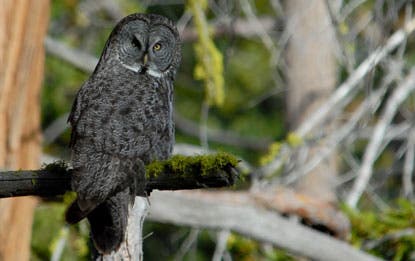The Great Gray Owls of Yosemite are a unique species, after they separated from their cousins some 30,000 years ago when an ice age forced them into isolation. Though similar to the Great Gray Owls, commonly encountered through out North America and the Asian taiga forests, the Yosemite branch is genetically distinct, but unfortunately also endangered with only 200 specimens left in the wild.

The giants with piercing yellow eyes and 5-foot wingspans have adapted so well to snow that they can dive face-first through up to a foot of it to catch the voles they hear creeping underneath. (c) Joe Medley / U.S. Forest Service
With such a fragile population, every measure of precaution must be taken. Tracking and tagging, indispensable to conservation efforts, is extremely difficult in such situations since it traumatizes the birds, disrupting matting cycles and nesting in the process. So, this summer researchers decided to tackle the situation with a different, more innovative approach – they used remote audio recording, coupled with complex software, to track and recognize individual Great Gray Owls through out the national park.
“Even if it takes only 15 minutes to trap a bird, it’s traumatic for them in the long term,” said Joe Medley, a PhD candidate in ecology at UC Davis who perfected computer voice recognition software to track the largest of North America’s owls. “With a population this small, we want to err on the side of caution in terms of the methods we use to get data.”
Thus, 40 data-compression digital audio recorders with high gain were placed in key areas of Yosemite, around the mid-elevation meadows typically favored by the owl known as Strix nebulosa Yosemitensis. By the end of the high tech owl spy experiment, Davis garnered some 50 terrabytes of recording – enough for seven years of continuous playing. Owl howls weren’t the only thing he ended up with though; all kinds of environmental sounds were picked up as well, from airplanes, to frogs, to shivering trees.
To solve this, Medley along with scientists at Cornell University Laboratory of Ornithology, developed a specialized software called Rave Pro. The program was able to recognize and filter the Great Gray Owls’ low-pitched hoot from the massive data, and discern males and females from juveniles. The software was even able to identify nesting females calling for food to help determine reproduction success.
“It’s capable of searching a week’s worth of data in an hour. What I was left with was owls and a host of other things that fell in the same bandwidth,” Medley said.
The researchers involved in the study hope that the same technique might be applied to observing other endangered species that are particularly sensitive to human interaction.
“These (owls) exist nowhere else in the world, and where they do occur is a pretty amazing location,” said Joshua Hull, a researcher with the U.S. Fish and Wildlife Service and adjunct professor at the University of California, Davis. “These are going in a different evolutionary direction than the others, and we don’t know where that is right now.”









